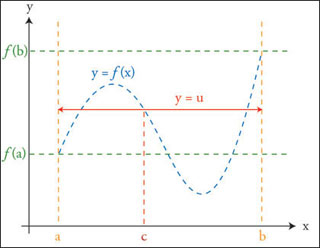
The Intermediate Value Theorem: If f is a function which is continuous on the closed interval [a, b], and u is a real number between f(a) and f(b), then there exists c in [a, b] such that f(c) = u. (Image by MIT OpenCourseWare.)
Instructor(s)
Prof. Arthur Mattuck
MIT Course Number
18.100A
As Taught In
Fall 2012
Level
Undergraduate
Course Description
Course Features
Course Highlights
This course features a somewhat gentler introduction to the standard Analysis I material than the traditional course. It emphasizes one-variable analysis and de-emphasizes point-set topology. It assumes students did well in a standard single-variable calculus course.
The textbook is written in a user-friendly style, discursive rather than brief, making the book usable for self-study.
Course Description
Analysis I (18.100) in its various versions covers fundamentals of mathematical analysis: continuity, differentiability, some form of the Riemann integral, sequences and series of numbers and functions, uniform convergence with applications to interchange of limit operations, some point-set topology, including some work in Euclidean n-space.
MIT students may choose to take one of three versions of 18.100: Option A (18.100A) chooses less abstract definitions and proofs, and gives applications where possible. Option B (18.100B) is more demanding and for students with more mathematical maturity; it places more emphasis from the beginning on point-set topology and n-space, whereas Option A is concerned primarily with analysis on the real line, saving for the last weeks work in 2-space (the plane) and its point-set topology. Option C (18.100C) is a 15-unit variant of Option B, with further instruction and practice in written and oral communication.


